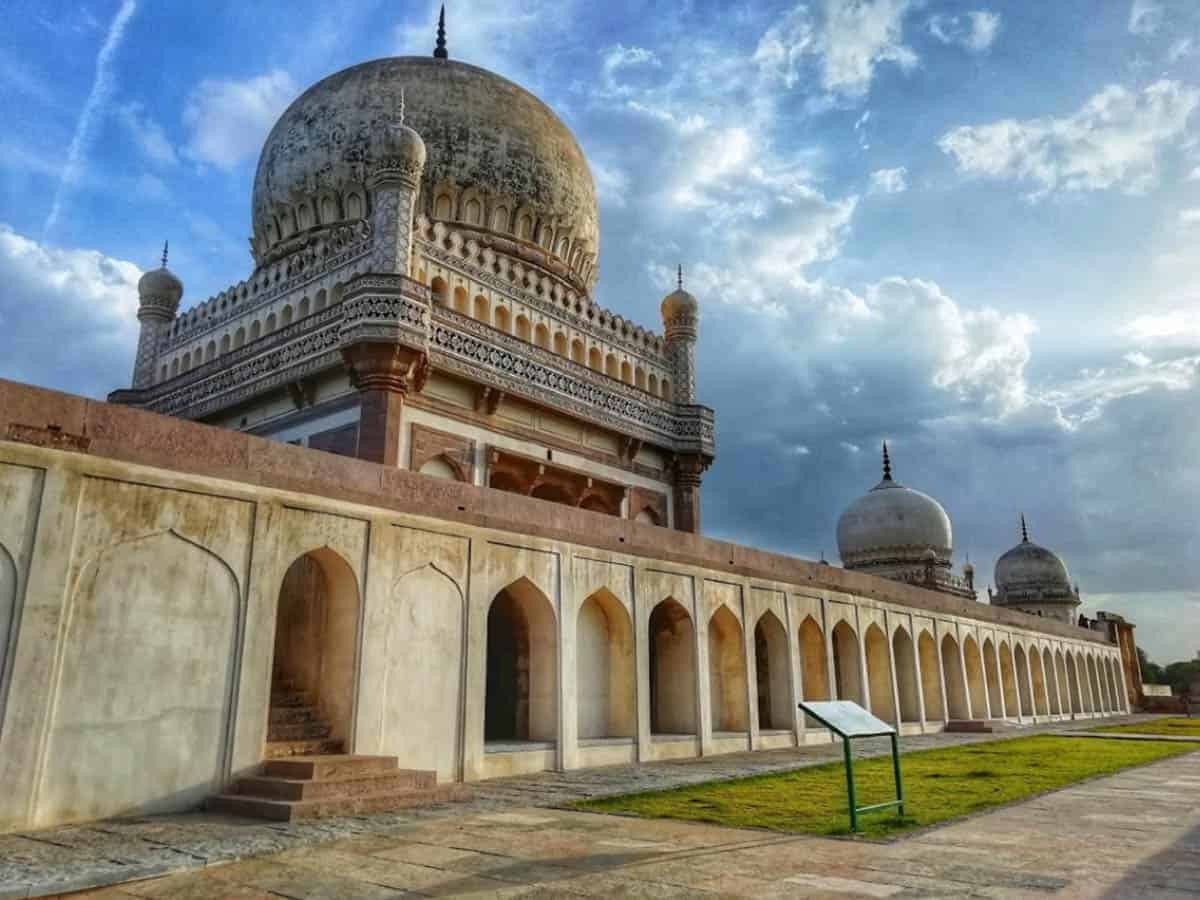Hyderabad: A visitor to the historic Qutub Shahi Tombs will be mesmerized by its architectural beauty. The colourful enameled tiles were used in decorating the tombs.
Quli Qutub Shah bears intricate carvings. The enameled tiling of the tomb made it unique from the other tombs.
The Aga Khan Trust for culture CEO Ratish Nanda said, “Qutub Shahi Tombs are fine examples of Indo-Iranian architecture.”
Nanda reviewed the restoration work done by his trust in collaboration with the Telangana State Archaeology and Museums Department which started in 2013 and was unveiled by the U.S. Ambassador to India on 10 March 2020.
While restoration work paused due to the Covid-19 pandemic, work has now continued at a slower rate.
Upon closer scrutiny, it was found that the enameled tiles used in domes were of blue, green, white, yellow, and red colours. These colours were very popular in the middle ages. The carvings on the dome and on Minarates are exquisite.
The original tiling work has been concealed behind a 40 mm lime coating. Nobody has seen the original tiles for years.
These Qutub Shahi tombs in Hyderabad are a major attraction of the city. These are a cluster of tombs and mosques built by the rulers of the Qutub Shahi dynasty.
The Qutub Shahi Tombs comprises of the seven tombs of the rulers of Qutub Shahi dynasty. Located quite close to the famous Golconda Fort in the city of Hyderabad, these tombs are considered to be some of the oldest monuments in the city.
Architecture of Qutub Shahi Tombs
Qutub Shahi Tombs are a blend of Persian and Indian architectural styles. The influences of Hindu, Pathan, Persian, and Deccan styles can be seen in the structures. Each tomb built here has a strong historical relevance.
Tomb of Sultan Quli Qutub ul Mulk
The tomb of Sultan Quli Qutub ul Mulk was built by the ruler himself in 1543 AD, and the structure of this tomb is the one that was later followed by his descendants. The tomb is crowned by a circular dome and is erected on a raised platform. This tomb is the simplest and modest tombs of those times. There are graves in the tomb and on the surrounding terrace. It is said that it was the King’s decision to have tombs built for the non-ruling members of the royal family.
Tomb of Jamshed Quli Qutub Shah
Jamshed Quli Qutub Shah’s tomb is next to his father Sultan Quli’s tomb. This tomb appears different from the other structures as it is two-storey. Another interesting factor about this tomb is that it is the one tomb which has not used black basalt for construction.
Tomb of Sultan Subhan Quli Qutub Shah
Standing between the tombs of his father’s and grandfather’s tombs, Sultan Subhan Quli Qutub Shah’s tomb is one with no inscriptions as he has ruled only for a short period. Sultan Shubhan was fondly called as Chhote Malik which translates to “Small Master”.
Tomb of Sultan Ibrahim Quli Qutub Shah
The fourth Sultan has his tomb slightly larger than that of Sultan Quli. This tomb has two graves in the centre and another 16 of them on the terrace, including the graves of his six sons and three daughters.
The tomb of Sultan Mohammad Quli Qutub Shah
This is the grandest tomb of all the tombs built for the Qutub Shahi rulers. This majestic mausoleum was built in 1602 AD, covering 65 sq. m. in area, on a raised platform of 4m. The Sultan was the founder of Hyderabad, and his mausoleum is rich in architecture with its ornamental parapets, carved pillars and false minarets. The tomb has entrances on the Southern and Eastern sides. And the inscriptions on it are in Persian and Naskh scripts.
Tomb of Mohammad Qutub Shah
The sixth ruler of the Qutub Shah dynasty also has a grand mausoleum built for him. The structure is adorned with enamelled tiles, giving it a royal look.
Tomb of Sultan Abdullah Qutub Shah
Sultan Abdullah Qutub Shah’s tomb is the last tomb built for the rulers of the dynasty, as the last ruler Abul Hasan was in prison during his death.
Other Tombs in the Complex
The other tombs here are of those of the non-ruling members of the royal family and of other eminent personalities like Sufi saints.

